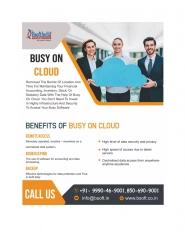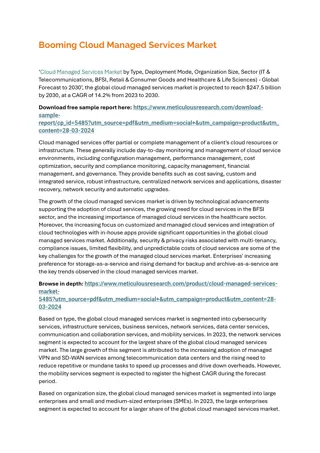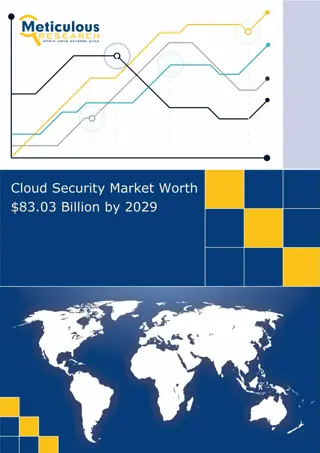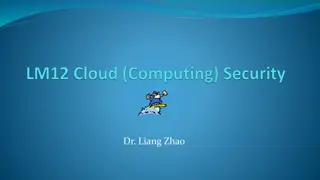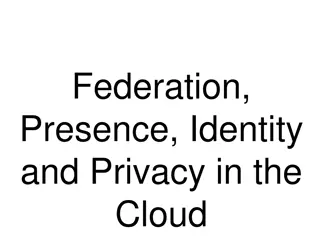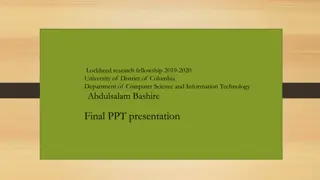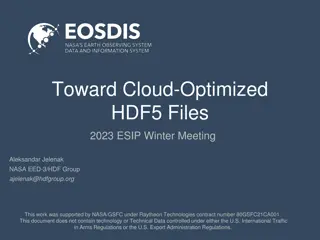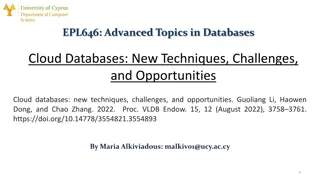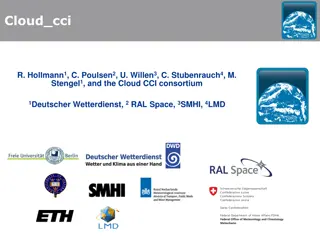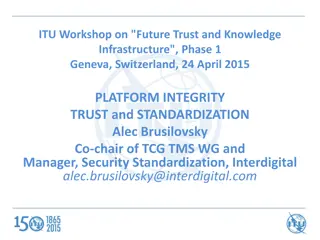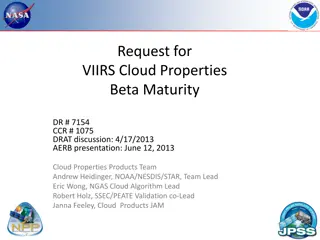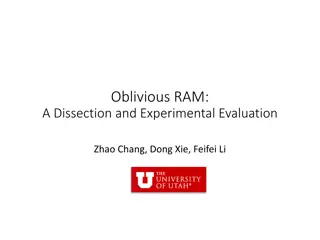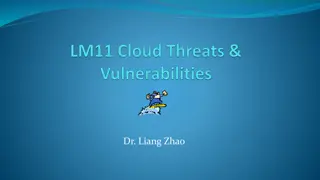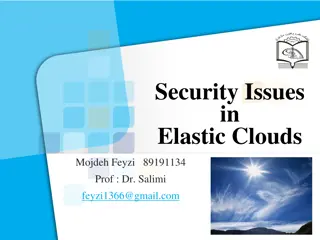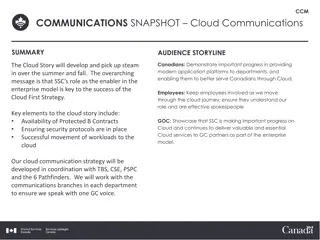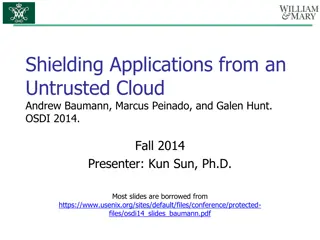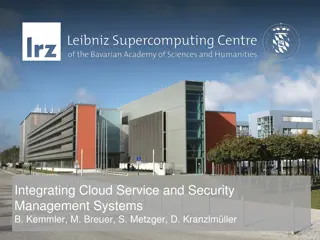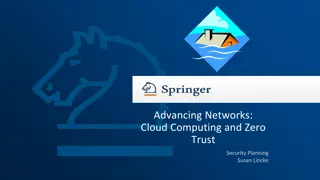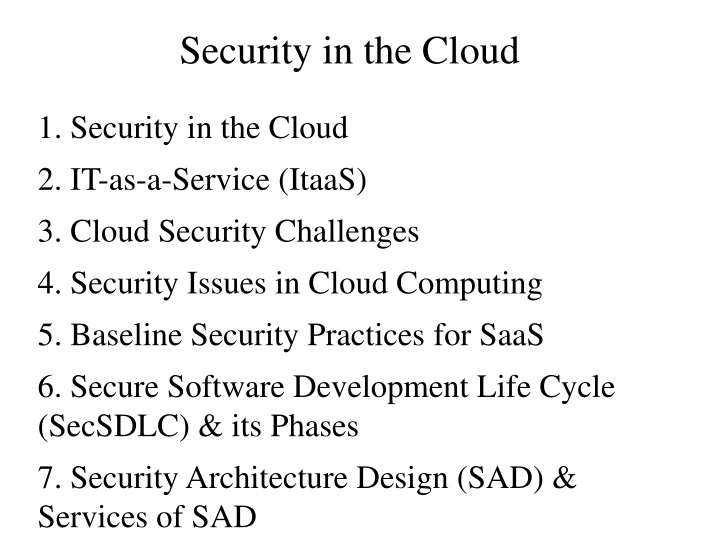
Ensuring Security in the Cloud: Methodology & Challenges
This content discusses security in cloud environments, focusing on ensuring application and data security during the transition from on-premises to public cloud. It covers security concerns in SaaS, PaaS, and IaaS, as well as ITaaS transformation and cloud security challenges such as loss of control over assets, encryption issues, and data integrity. Explore the complexities of securing data in cloud services.
Download Presentation

Please find below an Image/Link to download the presentation.
The content on the website is provided AS IS for your information and personal use only. It may not be sold, licensed, or shared on other websites without obtaining consent from the author. If you encounter any issues during the download, it is possible that the publisher has removed the file from their server.
You are allowed to download the files provided on this website for personal or commercial use, subject to the condition that they are used lawfully. All files are the property of their respective owners.
The content on the website is provided AS IS for your information and personal use only. It may not be sold, licensed, or shared on other websites without obtaining consent from the author.
E N D
Presentation Transcript
Security in the Cloud 1. Security in the Cloud 2. IT-as-a-Service (ItaaS) 3. Cloud Security Challenges 4. Security Issues in Cloud Computing 5. Baseline Security Practices for SaaS 6. Secure Software Development Life Cycle (SecSDLC) & its Phases 7. Security Architecture Design (SAD) & Services of SAD
Security in the Cloud Security concerns about cloud computing environments describes the methodology for ensuring application and data security and compliance integrity for those resources that are moving from on-premises to public cloud environments. Security in Software-as-a-Service (SaaS), Platform-as-a-Service (PaaS), and Infrastructure- as-a-Service (IaaS) environments
IT-as-a-Service (ITaaS) The modern IT organization must run itself as a separate operation and become more strategic in operational decisions. Many organizations are in the process of transforming their IT departments into self-sustaining cost-center operations, treating internal users as if they were customers. The adoption of IT-as-a-Service can help enterprise IT functions focus on strategic alignment with business goals.
Cloud Security Challenges 1. In the cloud, you lose control over assets in some respects, so your security model must be reassessed. 2. With the cloud model, you lose control over physical security. 3. Exposing your data in an environment shared with other companies could give the government reasonable cause to seize your assets because another company has violated the law.
Cloud Security Challenges 4. Storage services provided by one cloud vendor may be incompatible with another vendor s services Difficult to move from one to the other. 5. If information is encrypted while passing through the cloud, who controls the encryption/decryption keys? 6. Does data encrypted while it is at rest in the cloud vendor s storage pool.
Cloud Security Challenges 7. Common standard to ensure data integrity does not yet exist. Ensuring the integrity of the data really means that it changes only in response to authorized transactions. 8. Cloud applications undergo constant feature additions, and users must keep up to date with application improvements to be sure they are protected. The speed at which applications will change in the cloud will affect both the SDLC and security. This means that users must constantly upgrade, because an older version
Cloud Security Challenges 9. Core business practices provide competitive differentiation. Security needs to move to the data level, so that enterprises can be sure their data is protected wherever it goes. Sensitive data is the domain of the enterprise, not the cloud computing provider. One of the key challenges in cloud computing is data-level security. 10. Outsourcing means losing significant control over data
Cloud Security Challenges 11. Cloud-based services will result in many mobile IT users accessing business data and services without traversing the corporate network. So attackers no longer have to come onto the premises to steal data, and they can find it all in the one virtual location. 12. The dynamic and fluid nature of virtual machines will make it difficult to maintain the consistency of security and ensure the auditability of records.
Cloud Security Challenges 13. Proving the security state of a system and identifying the location of an insecure virtual machine will be challenging. 14. The co-location of multiple virtual machines increases the attack surface and risk of virtual machine-to-virtual machine compromise. 15. Virtual machine are vulnerable as they move between the private cloud and the public cloud.
Cloud Security Challenges 16. Enterprises are often required to prove that their security compliance is in accord with regulations, standards, and auditing practices, regardless of the location of the systems at which the data resides. 17. To establish zones of trust in the cloud, the virtual machines must be self-defending, effectively moving the perimeter to the virtual machine itself. 18. Enterprise perimeter security (i.e., firewalls, network segmentation, intrusion detection and prevention systems, monitoring tools, and the associated security policies) only controls the data that resides and transits behind the perimeter.
Security Issues in Cloud Computing The technology analyst and consulting firm Gartner lists seven security issues which one should discuss with a cloud- computing vendor: 1. Privileged user access Inquire about who has specialized access to data, and about the hiring and management of such administrators. 2. Regulatory compliance Make sure that the vendor is willing to undergo external audits and/or security certifications. 3. Data location Does the provider allow for any control over the location of data?
Security Issues in Cloud Computing 4.Data segregation Make sure that encryption is available at all stages, and that these encryption schemes were designed and tested by experienced professionals. 5. Recovery Find out what will happen to data in the case of a disaster. Do they offer complete restoration? If so, how long would that take? 6. Investigative support Does the vendor have the ability to investigate any inappropriate or illegal activity? 7. Long-term viability What will happen to data if the company goes out of business? How will data be returned, and in what format?
Baseline Security Practices for SaaS There are 29 baseline security practices for the SaaS environment as listed below. 1 Security Management (People) 2 Security Governance 3 Risk Management 4 Risk Assessment 5 Security Portfolio Management
Baseline Security Practices for SaaS 6 Security Awareness 7 Education and Training 8 Policies, Standards, and Guidelines 9 Secure Software Development Life Cycle (SecSDLC) 10 Security Monitoring and Incident Response 11 Third-Party Risk Management
Baseline Security Practices for SaaS 12 Requests for Information and Sales Support 13 Business Continuity Plan 14 Forensics 15 Security Architecture Design 16 Vulnerability Assessment 17 Password Assurance Testing
Baseline Security Practices for SaaS 18 Logging for Compliance and Security Investigations 19 Security Images 20 Data Privacy 21 Data Governance 22 Data Security 23 Application Security
Baseline Security Practices for SaaS 24 Virtual Machine Security 25 Identity Access Management (IAM) 26 Change Management 27 Physical Security 28 Business Continuity and Disaster Recovery 29 The Business Continuity Plan
Secure Software Development Life Cycle (SecSDLC) The SecSDLC involves identifying specific threats and the risks they represent, followed by design and implementation of specific controls to counter those threats. The SecSDLC must provide consistency, repeatability, and conformance. The SDLC consists of six phases.
Secure Software Development Life Cycle Phases Phase 1.Investigation: Define project processes and goals, and document them in the program security policy. Phase 2.Analysis: Analyze existing security policies and programs, analyze current threats and controls, examine legal issues, and perform risk analysis. Phase 3.Logical design: Develop a security blueprint, plan incident response actions, plan business responses to disaster, and determine the feasibility of continuing and/or outsourcing the project.
Secure Software Development Life Cycle Phases Phase 4.Physical design: Select technologies to support the security blueprint, develop a definition of a successful solution, design physical security measures to support technological solutions, and review and approve plans. Phase 5.Implementation: Buy or develop security solutions. At the end of this phase, present a tested package to management for approval. Phase 6.Maintenance: Constantly monitor, test, modify, update, and repair to respond to changing threats.
Security Architecture Design A security architecture framework should be established with consideration of processes (enterprise authentication and authorization, access control, confidentiality, integrity, non- repudiation, security management, etc.), operational procedures, technology specifications, people and organizational management, and security program compliance and reporting. A security architecture document should be developed that defines security and privacy principles to meet business objectives.
Services in Security Architecture Design 1. Authentication 2. Authorization 3. Availability 4. Confidentiality 5. Integrity 6. Accountability 7. Privacy
Data Governance A formal data governance framework should describe who can take what actions with what information, and when, under what circumstances, and using what methods. The data governance framework should include: 1. Data inventory 3. Data destruction 4. Data protection 5. Data privacy 6. Data retention/recovery/discovery 7. Data analysis (business intelligence) 2. Data classification
Key Components of Physical Security 1. Physical access control and monitoring, including 24/7/365 onsite security, biometric hand geometry readers inside man traps, bullet-resistant walls, concrete bollards, closed-circuit TV (CCTV) integrated video, and silent alarms. 2. Environmental controls and backup power: 3. Policies, processes, and procedures:

